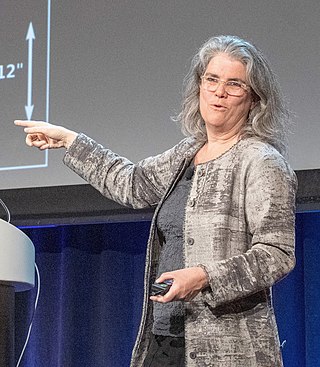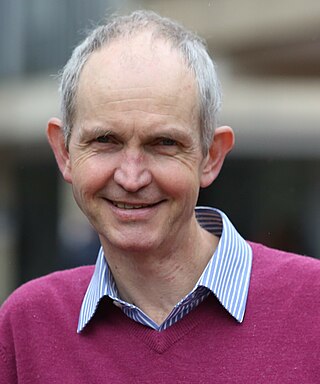Related Research Articles

The retina is the innermost, light-sensitive layer of tissue of the eye of most vertebrates and some molluscs. The optics of the eye create a focused two-dimensional image of the visual world on the retina, which then processes that image within the retina and sends nerve impulses along the optic nerve to the visual cortex to create visual perception. The retina serves a function which is in many ways analogous to that of the film or image sensor in a camera.

Optometry is a specialized health care profession that involves examining the eyes and related structures for defects or abnormalities. Optometrists are health care professionals who typically provide comprehensive eye care.

Andrea Mia Ghez is an American astrophysicist, Nobel laureate, and professor in the Department of Physics and Astronomy and the Lauren B. Leichtman & Arthur E. Levine chair in Astrophysics, at the University of California, Los Angeles. Her research focuses on the center of the Milky Way galaxy.
The Laboratory for Laser Energetics (LLE) is a scientific research facility which is part of the University of Rochester's south campus, located in Brighton, New York. The lab was established in 1970 with operations jointly funded by the United States Department of Energy, the University of Rochester and the New York State government. The Laser Lab was commissioned to investigate high-energy physics involving the interaction of extremely intense laser radiation with matter. Scientific experiments at the facility emphasize inertial confinement, direct drive, laser-induced fusion, fundamental plasma physics and astrophysics using the OMEGA Laser Facility. In June 1995, OMEGA became the world's highest-energy ultraviolet laser. The lab shares its building with the Center for Optoelectronics and Imaging and the Center for Optics Manufacturing. The Robert L. Sproull Center for Ultra High Intensity Laser Research was opened in 2005 and houses the OMEGA EP laser, which was completed in May 2008.
The Faculty of Science is one of six faculties at the University of Waterloo.
The School of Optometry and Vision Science is one of the professional schools at the University of Waterloo. It is a school within the university's Faculty of Science and is the larger of the two optometry schools in Canada. The School is the only English speaking Optometry School in the country; the Francophone Université de Montréal program operates in Quebec.
Karen K. Hsiao Ashe is a professor at the Department of Neurology and Neuroscience at the University of Minnesota (UMN) Medical School, where she holds the Edmund Wallace and Anne Marie Tulloch Chairs in Neurology and Neuroscience. She is the founding director of the N. Bud Grossman Center for Memory Research and Care, and her specific research interest is memory loss resulting from Alzheimer's disease and related dementias. Her research has included the development of an animal model of Alzheimer's.
Christine Van Broeckhoven is a Belgian molecular biologist and professor in Molecular genetics at the University of Antwerp. She is also leading the VIB Department of Molecular Genetics, University of Antwerp of the Flanders Institute for Biotechnology (VIB). Christine Van Broeckhoven does research on Alzheimer dementia, bipolar mental disorders and other neurological diseases. Since 1983 she has had her own laboratory for molecular genetics at the University of Antwerp, and since 2005 is focussing her research on neurodegenerative brain diseases. She is an associate editor of the scientific journal Genes, Brain and Behavior.
Sir John Anthony Hardy is a human geneticist and molecular biologist at the Reta Lila Weston Institute of Neurological Studies at University College London with research interests in neurological diseases.
Xi-Cheng Zhang is a Chinese-born American physicist, currently serving as the Parker Givens Chair of Optics at the University of Rochester, and the director of the Institute of Optics. He is also the Chairman of the Board and President of Zomega Terahertz Corporation.

The Herbert Wertheim School of Optometry & Vision Science at the University of California, Berkeley is an optometry school at the University of California, Berkeley. It offers a graduate-level, four-year professional program leading to the Doctor of Optometry degree (OD), and a one-year, ACOE-accredited residency program in clinical optometry specialties. It is also the home department for the multidisciplinary Vision Science Group at UC Berkeley, whose graduate students earn either MS or PhD degrees.
Ann Catrina Coleman FIEEE FOSA is a Scottish electrical engineer and professor at the University of Texas at Dallas specialising in semiconductor lasers.

Gerald Westheimer AM FRS is an Australian scientist at University of California, Berkeley researching the eye, its optics, and how we see details in space and in three dimensions.
ALPAO is a company which manufactures a range of adaptive optics products for use in research and industry, including deformable mirrors with large strokes, wavefront sensors, and adaptive optics loops. These products are designed for astronomy, vision science, microscopy, wireless optical communications, and laser applications.

Pablo Artal is a Spanish physicist and full professor specialized in optics at the University of Murcia, as well as in the development and application of new techniques in human vision research. He received the Spanish National Research award "Juan de la Cierva" and the Rey Jaime I Award for New Technologies in 2015. His main research topics are the optics of the eye and the retina and the development of optical and electronic imaging techniques in the field of biomedicine, ophtalmology and vision. He has contributed to the advance of methods for the study of the optics of the eye and contributed to the understanding of the factors that limit the resolution of the human vision. Moreover, his discoveries and ideas have been applied to instruments and devices used in the clinical practice of ophthalmology.
Colin Louis MastersMD is an Australian neuropathologist who researches Alzheimer's disease and other neurodegenerative disorders. He is laureate professor of pathology at the University of Melbourne.

Donna Theo Strickland is a Canadian optical physicist and pioneer in the field of pulsed lasers. She was awarded the Nobel Prize in Physics in 2018, together with Gérard Mourou, for the practical implementation of chirped pulse amplification. She is a professor at the University of Waterloo in Ontario, Canada.

Jonathan C. Knight, is a British physicist. He is the Pro Vice-Chancellor (Research) for the University of Bath where he has been Professor in the Department of Physics since 2000, and served as head of department. From 2005 to 2008, he was founding Director of the university's Centre for Photonics and Photonic Materials.
Rachel Wong is an American neuroscientist who is a professor of Biological Structure at the University of Washington. She studies the developmental mechanisms that determine synaptic connectivity in the central nervous system. She was elected to the National Vision Research Institute of Australia in 2018 and the National Academy of Sciences in 2021.
References
- 1 2 "Melanie Campbell". Waterloo Institute for Nanotechnology. 10 May 2012. Retrieved 2 October 2018.
- 1 2 3 "Melanie Campbell". Physics and Astronomy. 5 April 2012. Retrieved 2 October 2018.
- ↑ Campbell, Melanie (1 January 2015). "A Life-Changing View on Alzheimer's - Research2Reality". Research2Reality. Retrieved 2 October 2018.
- 1 2 3 "Citation for Melanie Campbell" (PDF). OCUFA. Retrieved 2 October 2018.
- ↑ Campbell, Melanie (1982). "Gradient refractive index optics and image quality in the rat eye". Open Research Library. Australian National University. doi:10.25911/5d69039fbef0b . Retrieved 2 October 2018.
- ↑ "The retina as a window to the brain". NSERC - Research News Details. 26 July 2016. Retrieved 2 October 2018.
- ↑ "How an eye scan can identify Alzheimer's disease early". CTVNews. 29 July 2016. Retrieved 2 October 2018.
- 1 2 Rumley, Johnathon (27 July 2016). "UW researchers behind new imaging technique to diagnose Alzheimer's disease". CBC. Retrieved 2 October 2018.
- ↑ "Why Eye Exams Are the Future of Alzheimer's Screening". Motherboard. 23 August 2016. Retrieved 2 October 2018.
- ↑ "Waterloo ceiling breaker Melanie Campbell challenges the status quo". Physics and Astronomy. University of Waterloo. 1 December 2015. Retrieved 2 October 2018.
- ↑ "Window on the Brain is Topic at 10th Earth Day Dinner". DailyNews. 16 April 2015. Retrieved 2 October 2018.
- ↑ "The Elizabeth Laird Memorial Lectures - Physics and Astronomy - Western University". www.physics.uwo.ca. Retrieved 2020-08-17.
- ↑ "CAP Medal Press Release - 2014 INO". services.cap.ca. Retrieved 2020-08-17.
- ↑ "Bobier and Woodruff lectures". Optometry & Vision Science. 2012-12-07. Retrieved 2020-08-17.
- ↑ "Past Prizes in Optoelectronics". www.rankprize.org. Retrieved 2020-08-17.
- ↑ "International Awards and Prizes to Researchers in Canada". science.gc.ca. Retrieved 2 October 2018.